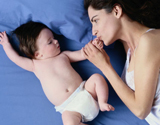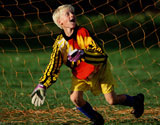
In-Toeing
 In-toeing, also commonly known as pigeon toes, involves walking with the feet turned inward. This condition may occur naturally in babies between 8 and 15 months when they first begin walking. It can be caused by an inward rotation of the thighbone or shin bone, or an abnormal inward bending of the foot.
In-toeing, also commonly known as pigeon toes, involves walking with the feet turned inward. This condition may occur naturally in babies between 8 and 15 months when they first begin walking. It can be caused by an inward rotation of the thighbone or shin bone, or an abnormal inward bending of the foot.
In most cases of in-toeing, both legs are equally affected. Girls are affected more often than boys. This condition is usually diagnosed before the age of three, but is most prominent between four and six. Some children may experience pain around the knee, but most cases of in-toeing are painless and do not produce any associated symptoms.
In-toeing does not usually require treatment and is often corrected on its own. While special braces were once used to correct this condition, it has now been proven that most cases of in-toeing will be gradually corrected on their own. In-toeing does not usually interfere with physical activity as your child grows.
Bowlegs
Bowleggedness is an outward bending of the legs from the knees down that affects most children under the age of 18 months. Most children are born bowlegged because of their folded position in the uterus, and the condition will continue to become more pronounced until the age of 18 months. When this condition continues past this age, it may be a sign of another condition such as Blount's disease.
Children with bowlegs may experience excessive tripping, in-toeing and knock knees as a result of this condition. Your child's doctor may perform an X-ray exam of the legs, but may not be able to distinguish if this is a serious problem until the child is older.
Most cases of bowlegs are corrected on their own as your child ages. More severe cases may require braces, special shoes, casts or surgery. If left untreated, this condition may cause trouble walking.
Juvenile Rheumatoid Arthritis
 Juvenile rheumatoid arthritis is a painful condition that involves an inflammation and stiffness of the joints for a period of six weeks or longer. Although this condition is not usually chronic like adult rheumatoid arthritis, it can cause serious symptoms and may affect bone development in growing children. Juvenile rheumatoid arthritis is an autoimmune disease that causes the immune system to attack its own healthy cells.
Juvenile rheumatoid arthritis is a painful condition that involves an inflammation and stiffness of the joints for a period of six weeks or longer. Although this condition is not usually chronic like adult rheumatoid arthritis, it can cause serious symptoms and may affect bone development in growing children. Juvenile rheumatoid arthritis is an autoimmune disease that causes the immune system to attack its own healthy cells.
Children with juvenile rheumatoid arthritis often experience soreness, swelling and stiffness within their joints, as well as rashes and high fever. These symptoms can affect just one joint or the entire body, depending on the type of juvenile rheumatoid arthritis that your child has.
- Oligoarticular JRA affects four or fewer joints in the body and most commonly affects the knee and wrist.
- Polyarticular arthritis affects five or more joints and is more common in girls than in boys.
- Systemic JRA affects the entire body and causes high fevers and an enlarged spleen and lymph nodes.
While most children will outgrow juvenile rheumatoid arthritis over time, there are several treatment options available to help reduce symptoms and minimize the condition's effect on your child's growth and development. Treatment may include anti-inflammatory medication, corticosteroids, physical therapy and maintaining a healthy and active lifestyle.
Fractures
A fracture is a break or crack in a bone that occurs when the bone cannot withstand the amount of force being placed on it, usually as a result of trauma, falls or a direct blow to the body. Fractures in children are different than in adults, as children's bones are softer and tend to bend or buckle rather than break. Healing is also faster in children's bones.
Fractures in children most commonly occur in the wrist, forearm and above the elbow, and can cause:
- Pain
- Swelling
- Physical deformity
- Difficulty moving
- Bruising
There are several different types of fractures that may occur, depending on the age of the child, the location of the fracture and the severity of the condition. Your child's doctor will perform an X-ray exam to determine what type of fracture it is. Because children's bones are softer than adults, they most commonly experience buckle or greenstick fractures, which involve a bending of the bone and sometimes a partial fracture on one side. Older children may experience a more severe break.
Treatment for a fracture depends on the type and severity of the condition, but usually involves immobilization with either a splint or a cast to help keep the bone in place for proper healing. More serious breaks may require surgery to help realign the bone and ensure that it stays together during the healing process. Your child's doctor will decide which treatment is best for your child's individual fracture.
Casting for Uncomplicated Fractures
 A fracture is a break or crack in the bone, often caused by extreme force or injury. Fractures are more common in children than adults because of their active lifestyle and pliable bones. Pediatric fractures often involve growth plates, areas of cartilage where the bones can grow.
A fracture is a break or crack in the bone, often caused by extreme force or injury. Fractures are more common in children than adults because of their active lifestyle and pliable bones. Pediatric fractures often involve growth plates, areas of cartilage where the bones can grow.
Although treatment for fractures varies depending on the location and severity of the injury, many can benefit from casting. Casting is usually needed for several weeks and helps hold the affected bone in place so that it can heal naturally. Casts require certain care to keep the area clean and dry, which help promote effective healing with no risk of infection or other complications.
Flatfoot
Most children are born with flat feet and develop arches as their bodies grow. However, in some children, the arch never develops, leaving the child with inward-turning ankles. While this condition is not usually serious, parents should seek medical attention for flatfoot, as it may cause pain. Some children also experience flexible flatfoot, a condition in which the arch disappears while standing, and then reappears when the child sits or is on tiptoes.
Your child's doctor can diagnose flatfoot by examining the feet and family history, as well as the child's everyday shoes for signs of abnormal wear. This condition should be monitored on a regular basis, and most cases will gradually improve by the time the child is five years old. If the condition persists and begins to cause pain, arch supports, physical therapy or casting may be recommended to relieve pain and correct the condition.
Muscular Dystrophy
Muscular dystrophy is a group of rare genetic diseases that causes the muscles to weaken and eventually break down, leaving children unable to perform tasks such as walking, sitting, moving the hands and arms, and breathing easily.
Although children are born with muscular dystrophy, they do not usually begin showing symptoms until they are a few years old, at which time they may begin to stumble, waddle, and have trouble standing up and pushing things. Symptoms may vary depending on the type of muscular dystrophy.
There are nine different types of muscular dystrophy, but most children with the condition have either Duchenne or Becker muscular dystrophy. Both of these conditions cause a gradual weakening of muscles and lack of coordination, progressively disabling the child.
While muscular dystrophy cannot be cured, there are several treatment options available to manage the symptoms of this condition and maximize your child's quality of life. Treatment for muscular dystrophy may include physical therapy, bracing, anti-inflammatory medication or walking devices. More severe cases may require surgery to release tendons or correct abnormalities of the spine.


